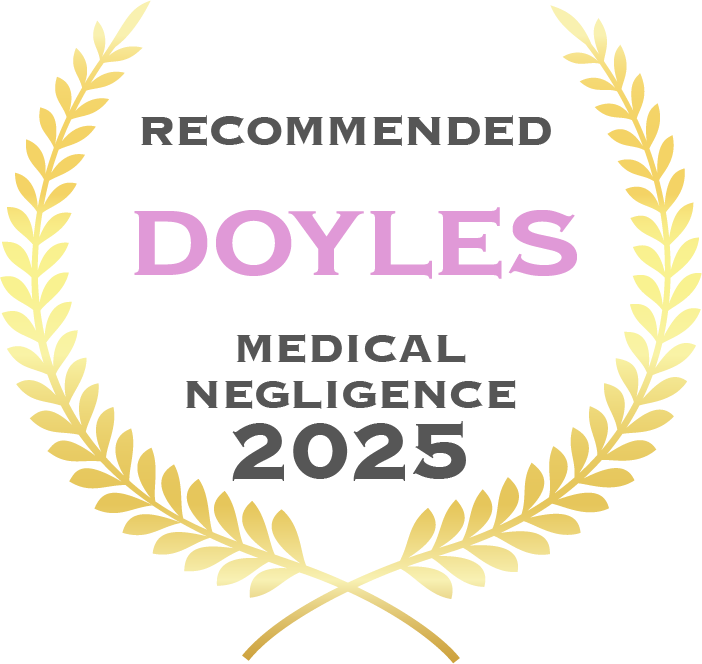Birth Injury
Lawyers
GMP Law specialises in birth injury claims across Australia, fighting for families affected by medical negligence during pregnancy, labour, or delivery.
We understand how birth injuries caused by medical negligence can have devastating, lifelong consequences for both the child and the family. Our experienced birth injury lawyers are here to help you seek justice, secure compensation, and hold healthcare providers accountable.
If you, or your baby, has suffered injury or loss as a result of a healthcare professional’s failure to fulfill their duty of care, speak to our trusted birth trauma lawyers today.

Birth injury claims:
Your rights, our fight
If you’re unsure whether you have a valid birth injury claim, you’re not alone. Many families are left with questions after a traumatic birth experience. We understand how deeply personal—and often painful—these situations can be. That’s why we take the time to listen to your story with care and compassion, and to fully understand the unique circumstances surrounding your case.
Our goal is to help you clearly understand your legal rights and determine whether you may be entitled to compensation for birth-related negligence.
You may have a claim if you or your child suffered harm due to medical negligence, preventable birth injuries, or mismanaged care during pregnancy, labour, or delivery.
How birth negligence can harm mothers
| Hospital negligence or medical error | Possible birth injury claims |
|---|---|
| Failure to diagnose or manage maternal conditions such as preeclampsia or gestational diabetes | Stroke, kidney failure, liver damage, preterm labour, or eclampsia. |
| Failure to act in obstetric emergencies (including prolonged labour requiring C-section) | Uterine rupture, bladder or bowel injury, severe bleeding, infection, or sepsis. |
| Administering incorrect medication or dosages | Severe allergic reactions, organ failure, seizures, or death. |
Birth injuries and trauma in newborns
Sadly, many birth injury malpractice cases involve preventable harm to newborns, including a wide range of physical and cognitive conditions.
If your child has experienced unexplained injuries, or been diagnosed with any of the following, you may have grounds for a birth injury claim:
| Hospital negligence or medical error | Possible birth injury claims |
|---|---|
| Failure in fetal monitoring and response | Serious birth trauma, cerebral palsy, hypoxic brain injury, seizures, or death. |
| Failure to perform a timely C-section | Brain damage, birth trauma, or neonatal complications. |
| Improper use of forceps or vacuum extraction | Shoulder dystocia, brachial plexus injuries (Erb’s palsy, Klumpke’s palsy), spinal cord injury, fractures, or nerve damage. |
| Medication errors during labour | Respiratory issues, heart problems, or long-term disabilities. |
| Failure to treat infections like Group B Streptococcus | Sepsis, meningitis, pneumonia, brain damage, or death. |
| Mismanagement of neonatal infections | Developmental delays or other unexplained conditions. |
Birth defects
While not all birth defects are preventable, some result from negligent medical care before or during pregnancy.
If a doctor failed to diagnose, prevent, or properly manage a condition that led to your baby being born with a defect, you may have a valid birth injury claim.
Prenatal medical negligence | Possible birth injury claims |
Failure to provide prenatal tests and genetic counselling | Chromosomal abnormalities, organ development issues, hereditary conditions, and a lack of informed decision-making. |
Failure to identify or act on known risk factors | Preventable birth defects, brain damage, or high-risk deliveries. |
Prescribing unsafe or contraindicated medications | Spinal cord injury at birth, developmental conditions, or organ malformations. |
Untreated maternal infections such as rubella or toxoplasmosis) | Brain damage, hearing loss, vision problems, or stillbirth. |
Failure to manage chronic maternal conditions, including diabetes | Premature birth, or neonatal complications. |
Errors in fertility treatments such as IVF | Multiple pregnancies or implantation issues leading to complications. |
Mistakes during prenatal procedures such as amniocentesis | Miscarriage, fetal injury, or long-term health issues. |
Even if you’re uncertain, we encourage you to reach out. Our free initial consultation means you can explore your options at no cost. You may be eligible for birth injury compensation, and you deserve to know the truth.
Speak with a birth injury lawyer now.
Why Choose Gerard Malouf & Partners
Birth negligence compensation: What can you claim?
When a birth injury occurs due to medical negligence, the consequences can be devastating, and sometimes lifelong. Compensation aims to support your child’s future and ease the emotional and financial burden on your family.
Our birth injury lawyers help clients claim compensation for both economic and non-economic damages resulting from medical malpractice.
Economic damages
- Medical and care expenses: Emergency treatment, surgeries, hospital stays, and ongoing therapies, including physiotherapy, occupational therapy, and speech therapy.
- Lifelong care and support: If your child will need full-time or specialist care, these costs can be claimed to ensure they have the support they need throughout their life.
- Loss of future earnings: In severe cases, your child may never be able to work. Compensation can help provide long-term financial security in place of future income.
- Home and transport modification: Wheelchair access, mobility aids, specialised vehicles, or home adjustments.
- Parental income loss: If you or your partner have had to stop working or reduce hours to provide care.
Non-economic damages
- Pain and suffering: For the physical discomfort and emotional distress your child may endure, now and in the future.
- Loss of enjoyment of life: If your child is unable to participate in school, play, social activities, or live independently.
- Psychological trauma: The mental health impact on your child, and also on you as parents, including conditions like PTSD.
- Grief and wrongful death: In the most tragic cases where a birth injury leads to a child’s death, families may be entitled to compensation for funeral costs, emotional trauma, and loss of life.
Family member claims in birth injury cases
In some situations, close family members may also be entitled to birth negligence compensation for the emotional, financial, and physical toll of caring for a child affected by birth medical negligence.
Family member claims
If you’re a parent or caregiver, you may be able to claim for:
The cost of providing long-term care
Emotional distress and nervous shock
Loss of relationship (loss of consortium)
Compensation for the strain birth trauma places on your bond with your child and your family life.
An experienced birth trauma attorney or lawyer for birth injury can guide you through what you’re entitled to under childbirth injury claims.
Our Unique Fee Reduction Guarantee
Satisfaction first:
Fees second
If our service fails to meet the high standards we set, we’ll reduce our fees. We are the only Australian firm that backs our service with a written cost reduction promise, giving you total confidence in your claim.
The compensation claim process: Your journey with GMP Law
Initial consultation
Evidence gathering
Claim submission
Negotiation
We’ll advocate fiercely on your behalf, aiming for a fair settlement that truly reflects your needs.
Court representation
Ongoing support
Why families choose us for birth injury claims
We understand how devastating a birth injury can be, emotionally, physically, and financially. When you’re focused on your child’s wellbeing, the last thing you need is the added pressure of legal costs. That’s why we offer a No Win, No Fee arrangement:
you won’t pay legal fees unless your case is successful.
Award-winning lawyers
Proudly recognised by Doyles Guide 2025 for excellence in legal services across medical negligence.
No Win No Fee.
Specialised expertise.
Proven results:
Nationwide legal support:
Free initial consultation
No Win No Fee
Fee transparency that you can trust
At GMP Law, we’re committed to ensuring you have nothing to lose with our No Win No Fee medical negligence service.
How our No Win No Fee system works:
No upfront costs
Start your claim without any financial risk
No contingency fees.
We don’t take a percentage of your settlement
Fair hourly rates.
When you win, we charge transparent hourly rates
Careful case evaluation.
We only take cases we believe can succeed
Our commitment. If we don’t believe your case will result in compensation or if costs outweigh benefits, we won’t take it on. This dedication to our clients’ best interests sets our No Win No Fee medical negligence lawyers apart.
Proven results: Birth injury case studies
Case 1: $10 million compensation for cerebral palsy due to delayed delivery
Background
A Sydney couple approached GMP Law when their son was diagnosed with cerebral palsy. The mother’s water had broken six days past her due date, but instead of admitting her, the local hospital sent her home.
It wasn’t until two days and two presentations later that she was finally admitted and her son delivered.
Medical negligence
The delay in proper care resulted in the child being deprived of oxygen in the womb, leading to cerebral palsy. The family faced the daunting prospect of lifelong care needs and substantial medical expenses.
GMP Law’s approach
- Conducted a thorough investigation, including detailed reviews of medical records.
- Engaged top medical experts to provide opinions on the standard of care.
- Demonstrated that the hospital’s actions fell below the accepted standard of care.
- Quantified the lifelong impact of the injury, including future care needs and lost earning potential.
Outcome
The case was settled for over $10 million at mediation.
This settlement provided the family with:
- Funds to modify their home for accessibility.
- Coverage for ongoing medical treatments and therapies.
- Resources for special education and assistive technologies.
- Compensation for the parents’ lost income due to caregiving responsibilities.
Case 2: $9 million settlement for Quadriplegic Dystonic Cerebral Palsy
Background
Medical negligence
GMP Law’s approach
- Analysed fetal heart rate monitoring strips to establish clear evidence of distress.
- Engaged obstetric experts to testify on the appropriate standard of care in such situations.
- Worked with life care planners to project the lifetime costs of the child’s care needs.
- Demonstrated the psychological impact on the family, including the parent’s need to become full-time carers.
Outcome
GMP Law’s team of cerebral palsy lawyers secured a $9 million settlement for the family.
The compensation covered:
- Lifelong medical care and therapies
- Home modifications and specialised equipment
- Loss
Case 3: $3.75 million settlement for Ataxic Cerebral Palsy and Hypoxic Ischaemic Encephalopathy
Background
Medical negligence
Despite clear risk factors—such as a history of large babies, epilepsy, and an unfavourable cervix—the hospital proceeded with induction without ensuring senior supervision.
The attending doctor was a recent graduate who used unreasonable manoeuvres to deliver the baby during a shoulder dystocia emergency. There was also a delay in providing adequate resuscitation, contributing to the baby’s severe and permanent disabilities.
GMP Law’s approach
- Obtained expert opinions supporting that the timing of induction and lack of senior oversight was inappropriate given the risk profile.
- Established that the vacuum-assisted delivery and manoeuvres used during shoulder dystocia were unreasonable and unsafe.
- Highlighted the delay in neonatal resuscitation as a contributing factor to the child’s condition.
- Demonstrated the child’s ongoing need for lifelong care due to intellectual and cognitive disabilities.
Outcome
GMP Law’s medical negligence lawyers secured a $3.75 million settlement for the family.
The compensation covered:
- Ongoing medical care and therapies
- Home support and equipment
- Costs associated with full-time care
- Loss of future earnings and support
What our clients say:
These are genuine reviews from real clients on Google, sharing their experiences with our medical negligence lawyers.
Turning injuries into justice, transforming lives through compensation
At GMP Law, we’re not just fighting for compensation, we’re fighting for your right to recover, rebuild, and reclaim your life after an injury. Read our medical negligence case studies:
$500,000 Settlement Following Nerve Damage From Varicose Veins Treatment
Case Overview Our client presented to a vascular surgeon, seeking treatment of her varicose veins in her right leg. Following the
Parents Receive total of $485,000 in Compensation for Tragic Death of Newborn Child
Case Overview Our client suffered unimaginable loss following her 12-hour labour, delivering her first child by emergence caesarean. A few hours
$9,000,000 settlement for negligence causing Cerebral Palsy
Case Overview Our client was born with Quadriplegic Dystonic Cerebral Palsy, which was caused by complications during delivery. During labour, our
$550,000 settlement for delayed referral to treat a blocked artery resulting in a stroke
Case Overview In June 2019, our client was an admitted patient of the First Defendant when he complained of chest pain
Sydney man receives $340,000 settlement following rotator cuff injury sustained during hospital admission
Case Overview Our client was admitted to his local hospital to undergo an elective procedure. It was known to the Hospital
$300,000 settlement for delayed diagnosis of bowel cancer
Case Overview In 2019, our client began experiencing abdominal pains and sporadic diarrhoea. Our client underwent an upper abdominal ultrasound which
Meet our birth injury lawyers
Meet our dynamic team of medical negligence lawyers, based in Melbourne, Sydney, Brisbane, and across Australia. With a 98% win rate and a No Win No Fee guarantee, we’re here to support your compensation claim.
Frequently asked questions about birth injury claims
What is the difference between a birth defect and a birth injury?
A birth defect is typically a condition that develops during pregnancy due to genetic or environmental factors, and often is not caused by medical negligence. However, in some cases, a birth defect may be linked to hospital negligence. For example, if prenatal care was inadequate or a known risk was not properly managed.
A birth injury, on the other hand, occurs during the birthing process and is more commonly associated with medical negligence if the injury could have been prevented through proper care and timely intervention.
How long do birth injury cases typically take to resolve?
Birth injury cases usually take between 18 months and three years to resolve.
The exact duration depends on factors like:
- The complexity of the case
- The severity of the injuries
- Whether the matter proceeds to trial
More complicated cases involving extensive medical evidence or legal challenges may take longer to conclude.
What are some common medical outcomes of birth negligence?
- Erb’s palsy: Nerve damage causing weakness or paralysis in the arm.
- Brain damage: Such as Hypoxic Ischaemic Encephalopathy leading to cognitive and physical impairments.
- Birth defects: Conditions that may arise from medical errors during pregnancy or delivery.
- Cerebral palsy: A group of disorders affecting movement and muscle tone.
- Permanent intellectual disabilities and developmental delays.
What types of experts are typically involved in birth injury cases?
Birth injury cases usually require input from several key medical experts:
- Obstetricians and gynecologists Review the care provided during pregnancy and delivery.
- Neonatologists Assess the newborn’s immediate health after birth.
- Pediatric Neurologists Diagnose and manage any neurological impairments.
- Rehabilitation Specialists Develop plans for ongoing therapies and treatments.
- Life Care Planners Calculate the long-term care and support costs the child will need.
Together, these experts provide essential medical evidence to support your claim and help secure maximum compensation.
Can I claim compensation if my child’s birth injury was diagnosed years after birth?
What if a hospital offers a settlement before I consult a lawyer?
You should never accept a hospital settlement offer without first speaking to a specialised birth injury lawyer. These early offers often undervalue the true cost of care, especially in cases involving hospital negligence.
Learn more about medical negligence
Understanding childcare negligence in Australia: A complete guide for parents
As parents, we trust childcare centres to provide a safe, nurturing environment where our little ones can learn, play, and grow.
What to do if the wrong medication was given to you as a patient
Discovering you’ve been given the wrong medication can be frightening and confusing. Whether the pharmacy gave wrong medication, the hospital gave
Medical negligence stroke cases
When a stroke occurs, every minute counts. The difference between recovery and permanent impairment can often come down to timely, accurate
Medical negligence: Know your legal rights
Medical negligence occurs when healthcare providers fail to meet accepted standards of care, resulting in patient harm. While Australia has one
Birth trauma compensation: Can you sue a hospital for a traumatic birth?
When you trust medical professionals with the most important moment of your life—bringing your child into the world—you expect safe, competent
Understanding delayed diagnosis in medical negligence cases
In healthcare, time is often a critical factor in patient outcomes. When medical professionals fail to provide timely diagnosis and treatment,









Talk to a birth injury lawyer today
Start with a free consultation. Call 1800 004 878, or request a call back below.















